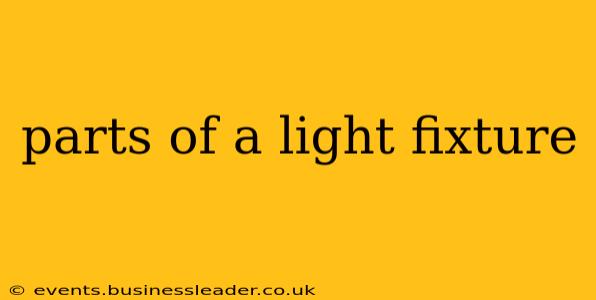Understanding the different parts of a light fixture is crucial whether you're installing a new one, repairing an old one, or simply curious about how they work. This comprehensive guide will break down the essential components, clarifying their functions and helping you navigate the world of lighting with confidence.
What are the main parts of a light fixture?
The core components of most light fixtures, regardless of style or type, generally include:
-
The Housing: This is the main body of the fixture, often made of metal or plastic, providing structural support and electrical protection. Its design varies widely depending on the fixture's style and intended use.
-
The Socket: This is where the light bulb is inserted and connected to the electrical circuit. Sockets come in various types, most commonly Edison screw (E26 or E27) and bayonet (BA15d). The type of socket determines the type of bulb compatible with the fixture.
-
The Wiring: This is the internal system of conductors that carry electricity from the power source to the bulb. Safe and correct wiring is paramount for both functionality and safety. Improper wiring can lead to electrical hazards.
-
The Lamp (Bulb): This is the light-producing element. It can be incandescent, fluorescent, LED, or halogen, each with its own energy efficiency and light output characteristics.
-
The Mounting Bracket/Hardware: This secures the fixture to the ceiling, wall, or other surface. It usually involves screws, bolts, or other fasteners designed to fit the specific fixture and mounting location.
What are the different types of light fixture sockets?
Edison Screw (E26/E27): This is the most common type of socket, featuring a threaded screw base. E26 is the standard in North America, while E27 is prevalent in Europe and other regions.
Bayonet (BA15d): This type uses two pins that are twisted and locked into place. It's less common than Edison screw sockets but is still used in many applications.
Other Socket Types: There are many other specialized sockets for different types of bulbs, including GU10, MR16, and G4, each designed to securely hold specific bulb types.
What are the different types of light fixture housings?
Light fixture housings are available in a vast array of materials, styles, and finishes. Common materials include:
-
Metal (Steel, Brass, Aluminum): Durable and offer good heat dissipation.
-
Plastic: Lighter and often more affordable, but may not be as durable or heat-resistant as metal.
-
Glass: Often used for decorative purposes, especially in pendant lights and chandeliers.
How do I identify the parts of my light fixture?
Carefully examine your light fixture. Start by identifying the main body (housing), then locate the socket where the bulb is inserted. Trace the wiring to understand its path. Finally, identify the mounting bracket and hardware used to secure the fixture. If you're unsure about any component, consult the fixture's installation instructions or seek professional advice.
What are the safety precautions when working with light fixtures?
Always remember safety is paramount when working with electrical components. Before working on any light fixture:
- Turn off the power: Switch off the breaker that supplies power to the circuit at the breaker box.
- Double-check: Use a non-contact voltage tester to verify the power is off.
- Use proper tools: Employ insulated tools to avoid electrical shocks.
- Seek professional help if needed: If you're not comfortable working with electricity, consult a qualified electrician.
By understanding the different parts of a light fixture and following safety precautions, you can confidently tackle installation, repair, or simply appreciate the engineering behind your home's lighting. Remember, if in doubt, consult a professional.
